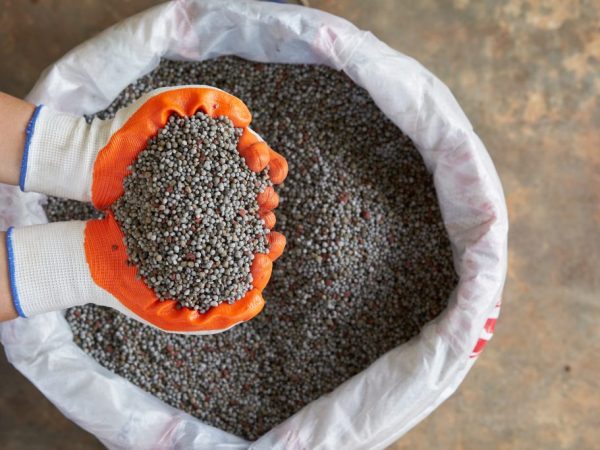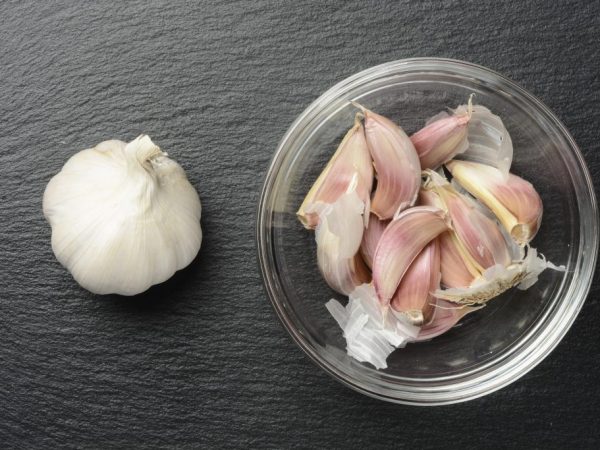How to feed garlic with ammonium nitrate
Among the many types of dressing, ammonium nitrate for garlic is one of the main fertilizers. This type of nutrients saturates the earth with nitrogen, which is necessary for the germination of cloves.

Top dressing of garlic with ammonium nitrate
Ammonium nitrate is mandatory introduced into the ground when planting in spring and autumn. However, the subsequent soil enrichment schedule depends on the type of land.
The composition of the ammonia feed
Ammonium nitrate is an extremely popular complex of minerals, since fast and high-quality nitrogen saturation is required by many plants during the active growing season. The nitrogen component of top dressing reaches 30%. This amount of the element allows vegetables to balance the amount of protein and gluten, as well as increase yields. In addition to the main component in the form of nitrogen, the composition also includes:
- sulfur (up to 15%);
- calcium;
- magnesium;
- potassium.
The percentage of these substances can vary depending on the type of mineral mixture. However, the predominant elements are sulfur and nitrogen.
Due to the presence of sulfur, the agrochemical is well absorbed by plants. Calcium and magnesium strengthen the fiber and accelerate the growth of seedlings.
Dignity
This type of mineral has many positive qualities. These include:
- relative cheapness;
- ease of use;
- the complexity of nutrients, which allows you to saturate the garlic with all the necessary elements;
- fast solubility in moist soil and water;
- effectiveness of exposure at cold temperatures.
Despite the fact that the amount of nitrogen in this agrochemical is less than in urea, top dressing is considered more versatile. Useful components are found in it in nitrate and amide forms. With the help of nitrates, minerals begin to be absorbed instantly, and thanks to the amide component, some of the useful components continue to act after a week.
Frost resistance should be mentioned separately. Organic matter begins to act only during the warm period, when the earth warms up. Because of this, winter garlic often suffers from mineral hunger in winter, so in early spring and late autumn, the agrochemical can be scattered over the snow. Thanks to its chemical formula, saltpeter burns through the ice cover and reaches the soil, instantly replenishing the nitrogen deficiency.
disadvantages

Poorly affects yields
Despite the large number of advantages, this type of fertilizer also has disadvantages. Among them are the following:
- the agrochemical is quickly washed out by groundwater, which is why plants may not have time to get the required amount of minerals;
- the structure of the soil is disturbed;
- an increase in soil acidity and an increase in the amount of salts, which can significantly reduce the yield;
- the nitrogen complex of substances may not be enough for good crop growth.
It is not recommended to mix nitrogen fertilizers with peat, sawdust, straw or lime. The presence of these components can cause the mixture to ignite.
You should also strictly adhere to the dosage of the mixture. A large amount of nitrogen in the soil leads to the formation of barren flowers.
Soil preparation
An important role is played by soil preparation before planting garlic. After marking the rows, two to three days before planting, 60 g per 1 m² for the winter variety and 40 g per 1 m² for the spring variety should be applied. At the same time, the soil must be drilled to a depth of 6-8 cm in two directions. This will contribute to the rapid development of culture.
Ammonium nitrate is safe for vegetable crops if you adhere to a soil enrichment schedule. Overfeeding the plants is not recommended - this can lead to a lot of ground greenery. The harvest from such seedlings, as a rule, has a low taste. At the first signs of soil oxidation, the rate of application of the agrochemical should be stopped or reduced.
Some farmers recommend stopping top dressing 20 days before harvest, but this can affect the amount of garlic. The optimal time for this is 14 days before digging out the heads.
Soil application
The first feeding of garlic with ammonium nitrate occurs in spring or autumn directly during planting. For 1 m² use 1 tbsp. substances or diluted with 30 g per 10 liters of water. In the spring, this should be done immediately after the snow melts, and in the fall - before the first frost. When using organic fertilizers, the feeding rate is reduced by half. During the growth of seedlings, this agrochemical is used as the main fertilizer or as an additional saturation. It depends on the type of soil:
- alkaline soil can be fertilized on a permanent basis;
- in oxidized soil, garlic nitrate is used in combination with organic fertilizers.
With each application, the composition should be well watered. This rule even works for a diluted chemical. For the entire growing season of garlic, it is advisable to carry out 4 dressings, and the latter should be applied two weeks before the harvest.
Recommendations
Many farmers recommend feeding plants with this agrochemical in combination with urea. This will improve the palatability of the fruit.
It is not recommended to apply nitrogen fertilizers by foliar method, as this can lead to burns of the arrow. In a hot period, an agrochemical can be fed only in a diluted form, otherwise part of the nitrogen will evaporate into the atmosphere. In cool weather, fertilizing is applied under a rake, however, for the best effect, the plants should be fed to a greater depth.
Storage
Store this type of feeding should be in a closed container. The storage room should have good air circulation and low humidity. Also, ammonium nitrate can catch fire on contact with flammable objects. It is necessary to monitor temperature differences in the room. They can lead to crystallization of nitrates and poor solubility of the feed.
To prevent the fertilizer from caking, it is recommended to mix it with magnesia. The shelf life of the agrochemical is 6 months.
Conclusion
The effect of ammonium nitrate on garlic is largely positive. This agrochemical accelerates the growth and development of plants, allowing you to get the maximum yield from any variety.
Thanks to this mixture, the soil is quickly enriched with nitrogen, which is necessary for garlic at an early stage of development. However, the soil should be fertilized in accordance with the application schedule, otherwise the excess of minerals can negatively affect the yield.


